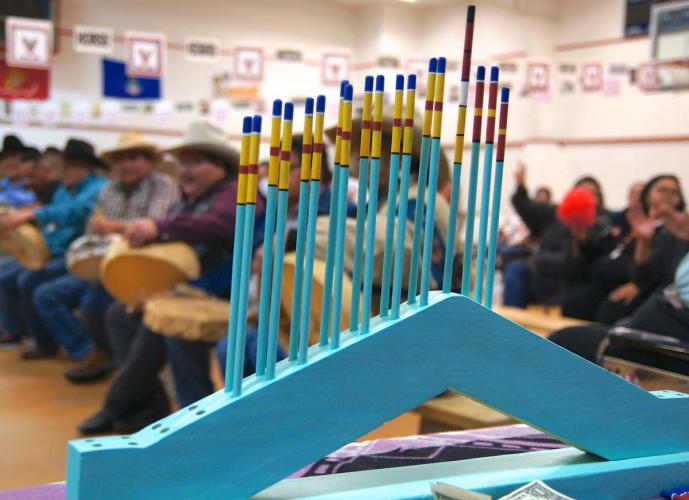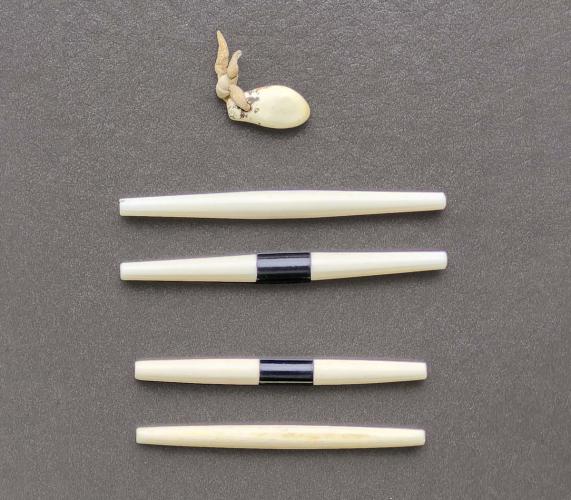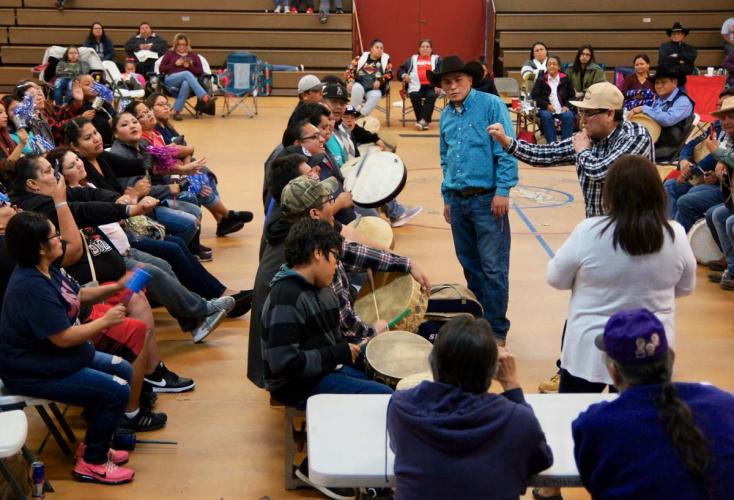In the Kiowa Tribe’s community center in Carnegie, Oklahoma, two teams sit across from each other. One player is hiding two pieces of carved bone in his closed hands, one of which is decorated with markings. On the other team, one player is trying to guess in which hand he is holding it. As the room fills with drumming, rattling and singing to distract the guesser, the tension builds. He gestures to indicate in which hand he thinks the player is hiding the decorated bone, but when the man opens his hand, it is the wrong one and he smiles, victorious. Once again, he has fooled his opponent. The room explodes with claps and cheers from the winning “handgame” team.
Like many traditional Indigenous games, the handgame is a pastime men, women and children used to play primarily in winter, when long, cold nights forced them inside. It was played mainly by tribes in the western United States and Canada. However, over generations, it has become a phenomenon across these countries, with some tournaments offering large monetary prizes to winning teams.
Some tribal stories say the game was a gift to people from “tricksters” such as Coyote. As skilled players were thought to have great power, animals and people played the game to chase away ancient monsters. Handgame pieces from some archaeological sites have been dated to as far back as 5,000 years ago.
The game has many variations, differing in the number of playing pieces, rules and points. However, in most versions, players sit in two groups, each team facing one another. One to four items—such as a single elk tooth or pairs of small carved bones or tubular beads called “hairpipes”—are hid in the closed hands of players on one team while someone from the other team attempts to correctly guess in which hand a designated game piece is hidden. Guesses are made with hand signs, which in the past allowed tribes to play each other regardless of what language each spoke.
Score is kept with a set of wooden sticks, often positioned between the two teams. Each time a hider is missed by the guesser, the hider’s team scores a point. When the pieces are correctly guessed, the teams switch roles, and the other one then hides or guesses.
Like poker, the skill involves trying to fool the other team by not giving away that you are holding the piece or, similar to noticing a poker player’s “tell,” by determining the hiding and guessing patterns of your opponents. “If you’re hiding, it is how you outwit the guesser, and, if you’re guessing, you really got to try to outdo the hider,” explained long-time Comanche Camp 7 team captain Carl Atauvich. “It’s just really competitive.”
Also like poker, some believe in a player’s power or luck. On some teams, the medicine man, or captain, engages in prolonged preparations of the pieces being hid prior to giving them to the hiders. In earlier times, a single item was hid, and players and medicine men skilled in sleight of hand could deceive opponents by throwing it from hand to hand undetected. If caught, the player was disqualified and any bets forfeited. Today, after hiding the pieces, players must keep both hands visible in front of them and open both hands after each guess to prevent any cheating.
In “free-for-alls,” players can be on either team and change sides after each game. The unpredictability of the spirited competition combined with the drumming and singing adds to the drama. A team may have a winning streak and sweep the game, or the game may go back and forth with a close score, each side guessing the other repeatedly until one side finally gets the winning point. “That’s a good handgame,” Kiowa player Jack Yellowhair said, “fighting for that [last] one.”
In addition to bringing tribes together for entertainment and socializing, as Jack’s son, Jackie Yellowhair, explained, “One of our first forms of commerce was this handgame.” Instead of money, two sets of arrows, jewelry, blankets, robes, saddles, horses and other items were matched between individuals on opposing sides and placed together prior to beginning play. The winning side received the paired items, with each winner essentially doubling their bet.
Today, tribes might host match games between two teams or tournaments between a group of particular teams to determine the ultimate winner. Such tournaments are held year-round, with prizes ranging from several hundred dollars to $40,000. Oklahoma holds a statewide handgame tournament in May. Each November, a Crow team from Montana comes to Oklahoma to play a series of games against the Kiowa, Comanche, Cheyenne and others. In May, a Kiowa-led team from Oklahoma reciprocates by playing in the annual Crow Handgame Tournament in Montana.
The game is often taught in public schools and universities in Native communities, some of which have their own handgame teams. Handgames are also played online, the primary rule being a hider’s hands cannot be out of sight, to prevent any possible cheating. This form gained popularity during the COVID-19 pandemic as teams could play others they normally could not due to distance. The First Americans Museum in Oklahoma City has a virtual handgame exhibition that enables a player to compete against animated players on a screen.
As the traditional Native game most widely played by young children through seniors in the United States, the handgame has formed a distinct community of players and teams that has created lasting bonds. “We just basically want to have fun,” Cheyenne player and handgame tournament organizer Mary Beaver said, “Whether it be Comanches or Kiowas, we see each other weekend after weekend. And a lot of friendships have really developed from that,” she said. “That’s our family. That’s our way.”



